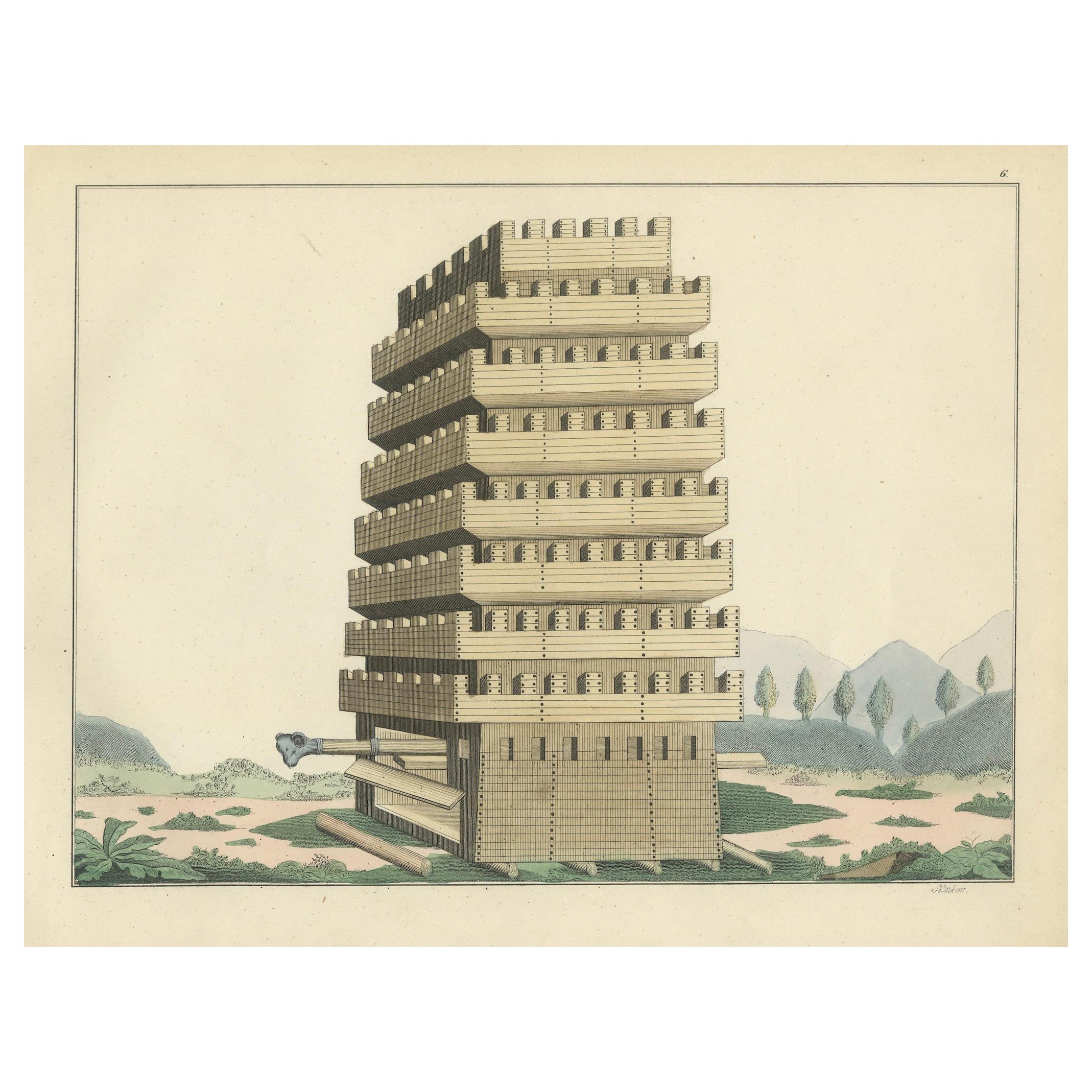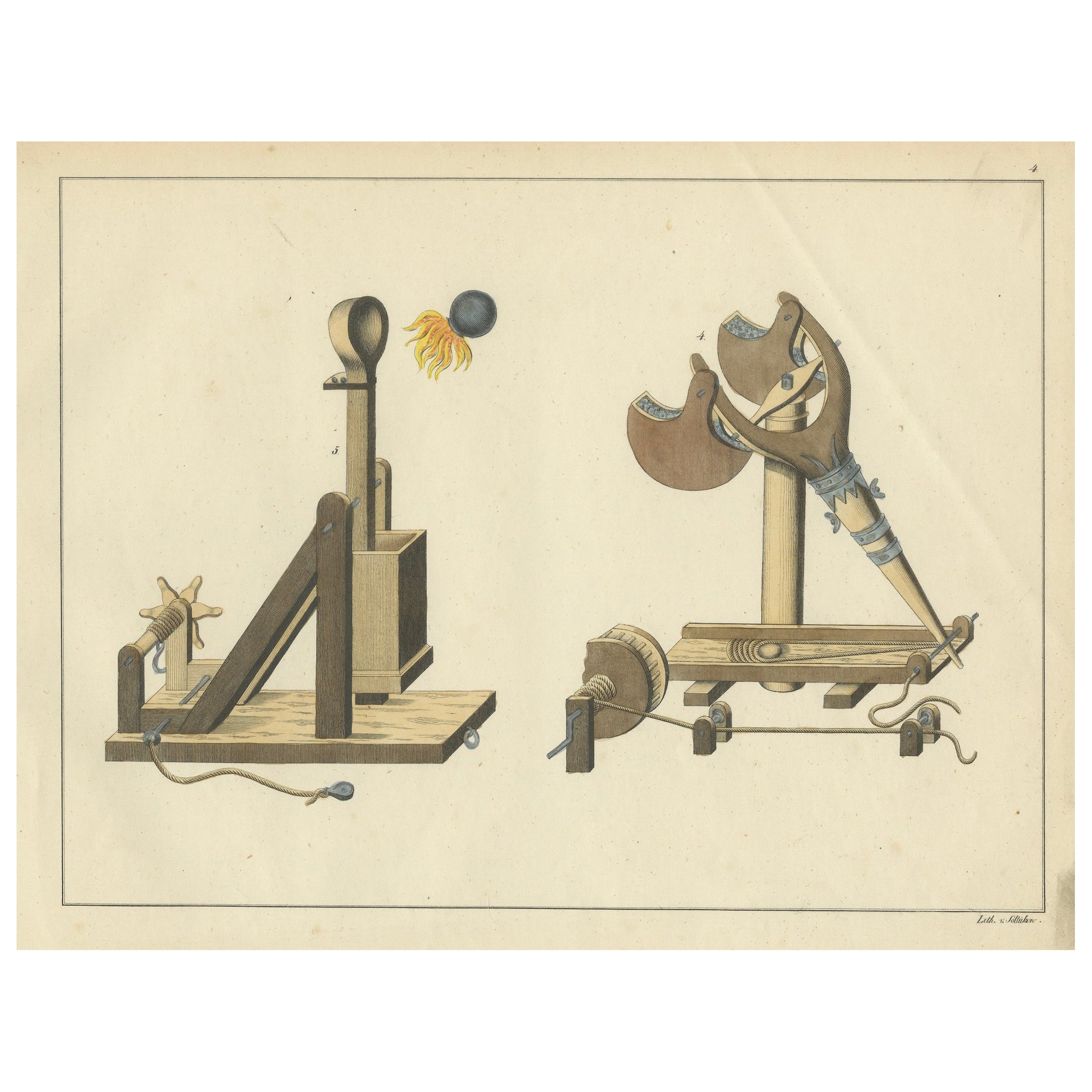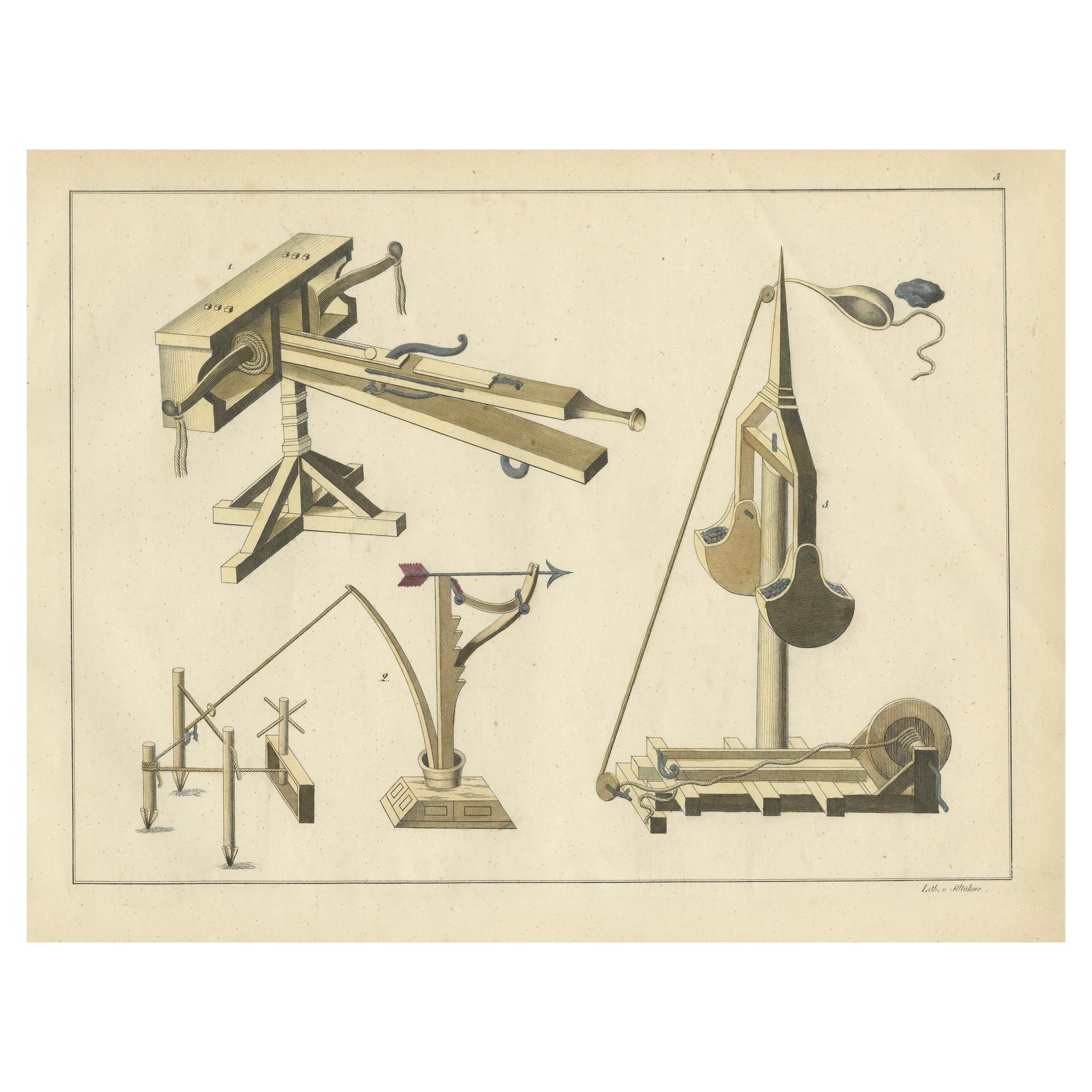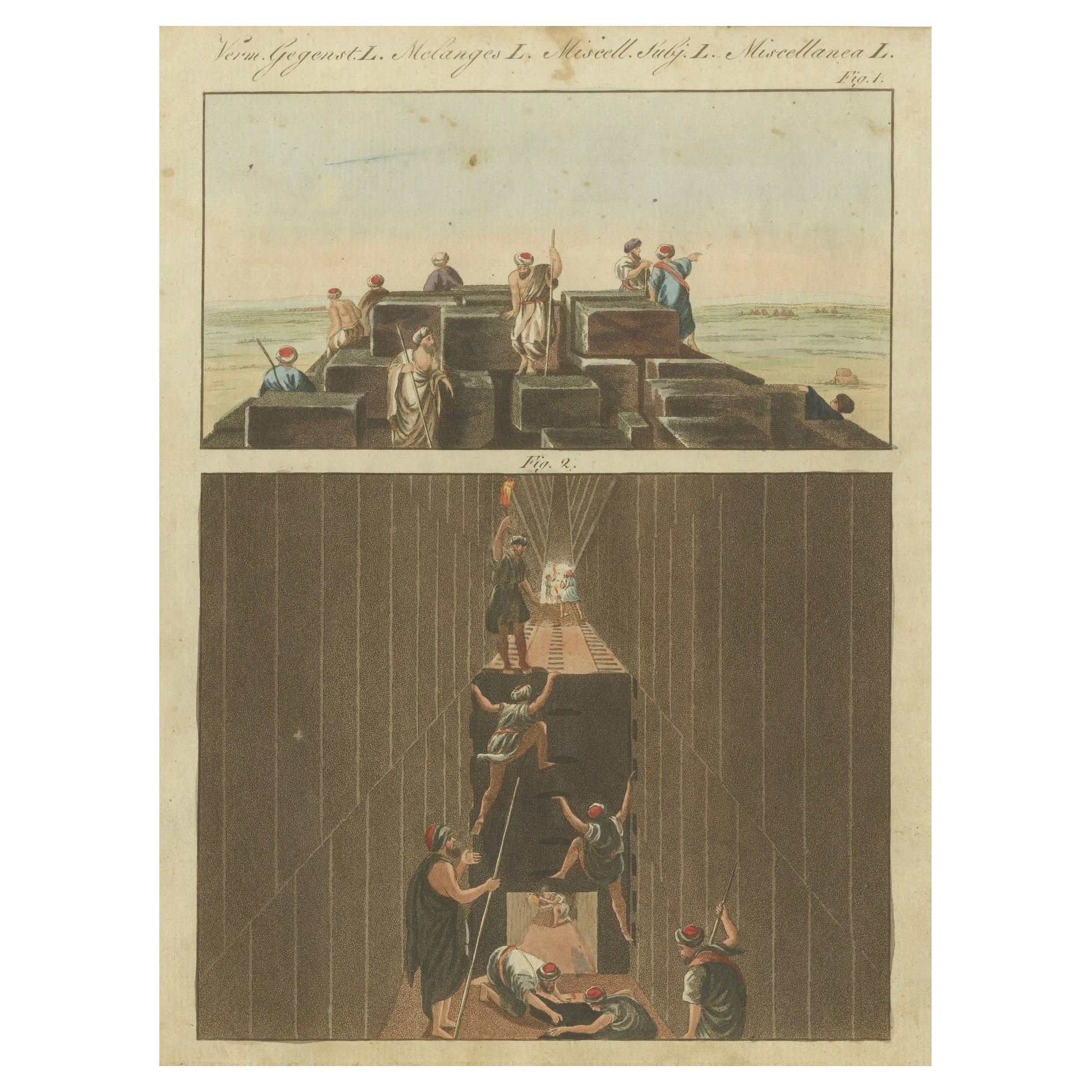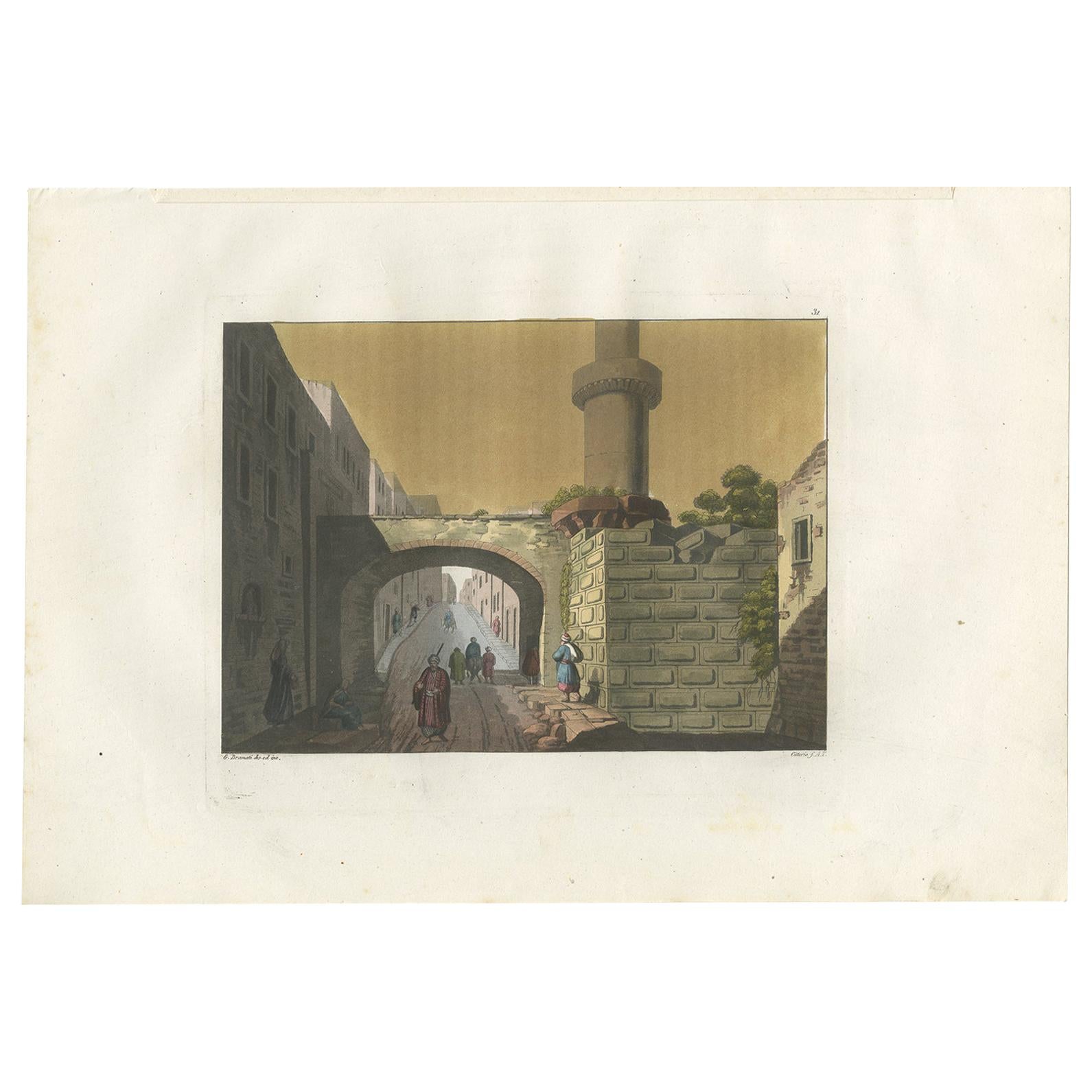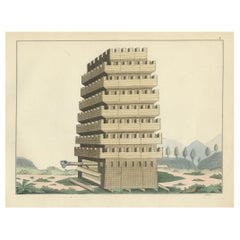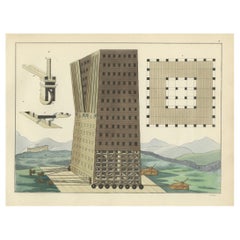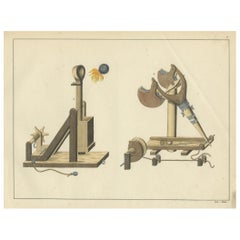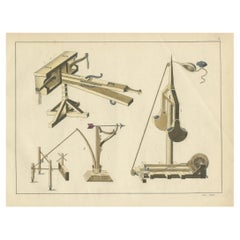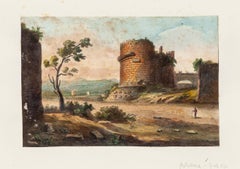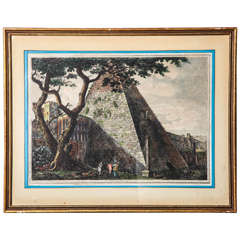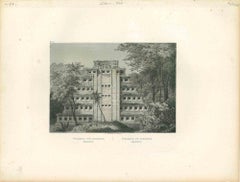Items Similar to 19th-Century Hand-Coloured Lithograph of a Medieval Siege Tower in Action
Want more images or videos?
Request additional images or videos from the seller
1 of 11
19th-Century Hand-Coloured Lithograph of a Medieval Siege Tower in Action
$575.97
$767.9625% Off
£424.75
£566.3425% Off
€480
€64025% Off
CA$795.41
CA$1,060.5425% Off
A$872.75
A$1,163.6725% Off
CHF 456.76
CHF 609.0125% Off
MX$10,740.61
MX$14,320.8125% Off
NOK 5,754.45
NOK 7,672.6125% Off
SEK 5,389.90
SEK 7,186.5425% Off
DKK 3,655.79
DKK 4,874.3925% Off
About the Item
Title: 19th-Century Hand-Coloured Lithograph of a Medieval Siege Tower in Action
Description: This exceptional hand-coloured lithograph depicts a towering Medieval siege tower, a critical war engine used in ancient and medieval warfare to breach fortified walls.
The print comes from the celebrated 1842 work 'Der Rittersaal: Eine Geschichte des Ritterthums' by Friedrich Martin von Reibisch and Dr. Franz Kottenkamp, exploring the history and evolution of knighthood, warfare, and chivalry.
The scene vividly illustrates the immense scale and complexity of siege warfare. The multi-leveled wooden siege tower, complete with small windows and battlements, is shown being maneuvered across the battlefield with the aid of soldiers and large ropes. At the base, figures work to position the heavy structure, while at the top, rows of knights and archers prepare for the assault. The backdrop of rolling hills and greenery adds depth and realism to this remarkable historical depiction.
Siege towers like the one depicted in this lithograph were used in numerous battles throughout ancient and medieval history, particularly during large-scale sieges of fortified cities or castles. Their primary function was to allow attacking forces to scale high walls while providing cover from defensive projectiles. Below are some notable historical periods and battles where siege towers played a role:
---
1. Ancient Battles
- Siege of Troy (circa 12th or 13th century BCE, legendary): While primarily referenced in 'The Iliad', various siege devices, including possible towers, were imagined as part of the assault on Troy's walls.
- Siege of Nineveh (612 BCE): The Babylonians, Medes, and Scythians used siege engines, likely including towers, to breach the Assyrian capital's formidable walls.
- Siege of Tyre (332 BCE): Alexander the Great famously used innovative siege techniques, including movable towers, to conquer the island city of Tyre.
2. Roman Battles
- Siege of Avaricum (52 BCE): Julius Caesar's forces built massive siege towers to breach the walls of this Gallic stronghold during the Gallic Wars.
- Siege of Jerusalem (70 CE): Roman forces under Titus used siege towers to attack the fortified walls of Jerusalem during the Jewish-Roman War.
3. Medieval Battles
- Siege of Antioch (1097-1098, First Crusade): Crusaders constructed siege towers to assault the city's formidable walls, ultimately capturing the city.
- Siege of Jerusalem (1099, First Crusade): The Crusaders famously used wooden siege towers to breach Jerusalem's heavily defended walls.
- Siege of Acre (1189-1191, Third Crusade): Richard the Lionheart's forces used siege towers and other engines to take this strategically vital city.
- Siege of Constantinople (1204, Fourth Crusade): Siege towers and other devices were employed by the Crusaders to breach the city's defenses.
4. Late Medieval Battles
- Siege of Orléans (1428-1429, Hundred Years' War): While cannons were already in use, the English used siege towers as part of their assault on Orléans.
- Siege of Rhodes (1480): The Ottoman Empire brought massive siege towers to attack the Knights Hospitaller defending Rhodes.
---
Siege towers were primarily used in battles where defenders relied on tall fortifications. Constructed on-site from wood, they provided archers and infantry a protected way to assault walls. As gunpowder and cannons became prevalent in the late Middle Ages, siege towers fell out of use, as fortifications could be breached more efficiently through artillery bombardment.
This lithograph likely references the siege engines of the Crusades or similar medieval campaigns, where such towers were iconic symbols of military ingenuity.
Condition: This lithograph is in excellent condition for its age, with clean margins and vibrant, carefully applied hand-colouring. Light toning and minor creases at the edges add character while maintaining its overall appeal.
This rare and visually stunning piece is perfect for collectors of military history, medieval siege technology, or enthusiasts of knightly art. Its detailed craftsmanship and historical significance make it an ideal candidate for framing and display in a study, office, or gallery.
- Dimensions:Height: 9.06 in (23 cm)Width: 11.03 in (28 cm)Depth: 0.01 in (0.2 mm)
- Materials and Techniques:
- Place of Origin:
- Period:
- Date of Manufacture:1842
- Condition:Condition: This lithograph is in excellent condition for its age, with clean margins and vibrant, carefully applied hand-colouring. Light toning and minor creases at the edges add character while maintaining its overall appeal.
- Seller Location:Langweer, NL
- Reference Number:Seller: BG-14009-71stDibs: LU3054342787982
About the Seller
5.0
Recognized Seller
These prestigious sellers are industry leaders and represent the highest echelon for item quality and design.
Platinum Seller
Premium sellers with a 4.7+ rating and 24-hour response times
Established in 2009
1stDibs seller since 2017
2,618 sales on 1stDibs
Typical response time: <1 hour
- ShippingRetrieving quote...Shipping from: Langweer, Netherlands
- Return Policy
Authenticity Guarantee
In the unlikely event there’s an issue with an item’s authenticity, contact us within 1 year for a full refund. DetailsMoney-Back Guarantee
If your item is not as described, is damaged in transit, or does not arrive, contact us within 7 days for a full refund. Details24-Hour Cancellation
You have a 24-hour grace period in which to reconsider your purchase, with no questions asked.Vetted Professional Sellers
Our world-class sellers must adhere to strict standards for service and quality, maintaining the integrity of our listings.Price-Match Guarantee
If you find that a seller listed the same item for a lower price elsewhere, we’ll match it.Trusted Global Delivery
Our best-in-class carrier network provides specialized shipping options worldwide, including custom delivery.More From This Seller
View All19th-Century Hand-Coloured Lithograph of a Multi-Level Medieval Siege Tower
Located in Langweer, NL
19th-Century Hand-Coloured Lithograph of a Multi-Level Medieval Siege Tower
This impressive hand-coloured lithograph features a detailed depiction of a multi-level medieval siege ...
Category
Antique 1840s German Prints
Materials
Paper
$422 Sale Price
20% Off
19th-Century Detailed Hand-Coloured Lithograph of a Large Medieval Siege Tower
Located in Langweer, NL
19th-Century Hand-Coloured Lithograph of a Large Medieval Siege Tower with Details
Description: This finely executed hand-coloured lithograph presents a massive 'medieval siege tower', complete with structural details and mechanisms used during large-scale sieges. Taken from the 1842 publication 'Der Rittersaal: Eine Geschichte des Ritterthums', this work by Friedrich Martin von Reibisch and Dr. Franz Kottenkamp highlights the engineering ingenuity of siege warfare during the Middle Ages.
The central focus of the illustration is the monumental siege tower, meticulously depicted with wooden reinforcements, a sloped base, and numerous small windows for archers and infantry. Wheels at the foundation highlight the mobility of this immense structure, while a wooden floor plan in the top right corner provides an aerial view of its grid-based layout. Additionally, the inset diagrams on the left showcase key mechanical components, including pulley systems and structural beams used to assemble or operate the tower effectively.
In the foreground, two smaller siege devices are displayed, likely for additional artillery or defensive support. The rolling landscape, complete with castles and distant hills, adds a scenic backdrop that complements the detailed technical rendering.
Condition: This lithograph remains in very good condition, with well-preserved hand-colouring and sharp, clear lines. Minor age-toning and light foxing add to the print’s antique charm without diminishing its visual impact.
Ideal for collectors of military history, medieval warfare, or engineering art...
Category
Antique 1840s Prints
Materials
Paper
19th-Century Hand-Coloured Lithograph of Medieval Catapults and Siege Engines
Located in Langweer, NL
Title: 19th-Century Hand-Coloured Lithograph of Medieval Catapults and Siege Engines
Description: This finely hand-coloured lithograph features two intricately designed 'medieval ...
Category
Antique 1840s Prints
Materials
Paper
19th-Century Hand-Coloured Lithograph of Medieval Siege Engines and Catapults
Located in Langweer, NL
Title: 19th-Century Hand-Coloured Lithograph of Medieval Siege Engines and Catapults
Description: This meticulously detailed hand-coloured lithograph illustrates a series of medie...
Category
Antique 1840s Prints
Materials
Paper
1805 Hand-Colored Engraving of Ancient Pyramid Construction from Bertuch’s Work
Located in Langweer, NL
Title: 1805 Hand-Colored Engraving of Ancient Pyramid Construction from Bertuch’s Work
Description: This remarkable hand-colored engraving is from Friedrich Justin Bertuch’s *Port...
Category
Antique Early 1800s Prints
Materials
Paper
Antique Print of Ruins of the Antonia Tower by Ferrario '1831'
Located in Langweer, NL
Original antique print of ruins of the Antonia tower. This print originates from 'Costume Antico e Moderno: Palestine, China, India, Oceania' by Ferrario. Published 1831.
Category
Antique Mid-19th Century Prints
Materials
Paper
$239 Sale Price
20% Off
You May Also Like
Tomb of Caecilia Metella - Hand Watercolored Etching - 19th Century
Located in Roma, IT
Tomb of Caecilia Metella is an original etching, hand-colored on paper realized by an Anonymous artist of the XIX century, the state of artwork is good with some foxing on the upper ...
Category
19th Century Figurative Prints
Materials
Watercolor, Etching
"Veduta Della Pirimide Di C. Cestio" Hand-Tinted Engraving by Luigi Rossini
By Luigi Rossini
Located in New York, NY
Picturesque 1822 engraving of the pyramid built as a tomb for Gaius Cestius, circa 18 BC. Luigi Rossini (1790-1857) was an Italian artist celebrated for his view...
Category
Antique 1820s Italian Neoclassical Prints
19th Century Hand-Colored Engraving on a Paper, France
Located in Sofia, BG
Fine engraving of the peaceful landscape of Orcière in France with a few figures on the road.
France, circa 1890.
Category
Antique Late 19th Century French Drawings
Materials
Paper
Ancient View of the Pyramid of Papantla - Original Lithograph - Early 1800
Located in Roma, IT
Ancient View of the Pyramid of Papantla is an original modern artwork realized in France in the first half of the 19th Century.
Original Lithograp...
Category
Early 19th Century Modern Figurative Prints
Materials
Lithograph
Large Drawing of Water Tower at Fort Ethan Allen
Located in Tarrytown, NY
Large drawing of water tower at Fort Ethan Allen in a wood frame. Purchased from an East Hampton Estate. Brown stains on print.
Category
Vintage 1930s Drawings
Materials
Paper
Tesoreria d'Atrée - Etching and Watercolor - Late 19th Century
Located in Roma, IT
Image dimensions: 10 x 14.5 cm.
Tesoreria d'Atrée is a hand-colored lithograph on paper, representing the Treasure of Atreus, sometimes called Tomb of Agamemnon, the impressive tholos tomb located in Mycenae, Greece (on the hill called Panagitsa) and built around 1250 BC., discovered by the archaeologist Heinrich Schliemann...
Category
Late 19th Century Modern Figurative Prints
Materials
Etching, Watercolor
More Ways To Browse
1980s Wall Hanging
19th Century Bronze Goat
19th Century Coromandel Cabinets
19th Century French Canopy Beds
19th Century Spanish Olive Oil Jar
2 Door China Cabinet
2 Tiered Lamp
20th Century Wrought Iron Pot Rack
3 Drawer Commode Pair
3 Piece Antique French Clock Garniture
3 Piece French Clock
4 Fold Screen Chinese
4 Poster Carved Wood Beds
Aalto Drawers
Acid Green Glass Vase
Adams China
Adelaide Antique Furniture
Adirondack Wicker
